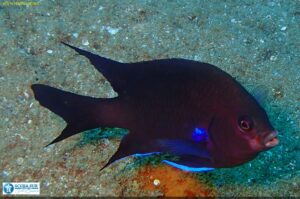The Canary Damsel fish is a small but aggressive little thing.
On every dive you will find them, the little black devils that think they can attack the giants. The Canary Damsel male will charge fearlessly at any predator coming too close to its nest, whether it’s an octopus or a diver.

- How to recognize the Canary damsel fish?
- Scuba Diving
- The Canary damsel fish diet
- Some Science
- More Information
The attacking males are known to bite the fingers of divers trying to take a picture. It does not really hurt but it is surprising…
How to recognize the Canary damsel fish?
The little dark brown to black fishes (up to about 15cm) with an explicit electric blue on the fins have large eyes and pronounced lips. The juveniles change colours as they mature, from completely blue, over black with lateral stripes until they get their adult colour. You can find them in rocky reefs and sandy-weedy areas somewhere between 5 and 45 m deep.
Canary damsels inhabit rocky areas, where they lay eggs that are (sometimes heavily) defended by males.
On Mogan Wreck, one of the famous southern dive sites, you find a damsel who thinks the wreck is his. He is really famous and figures on many photographs.
Scuba Diving
The Canary Damsel is found in the eastern Atlantic Ocean and therefore is a fixed sighting when diving the Canary Islands.
Despite the occasional attacks from the males defending their nests, they do not pose any danger for scuba divers.
The Canary damsel fish diet
It feeds on small plankton and algae, not on diver fingers!
Some Science
| Kingdom | Animalia |
| Phylum | Chordata |
| Class | Actinopterygii |
| Family | Pomacentridae |
| Genus | Abudefduf |
| Species | Abudefduf luridus |
More Information
We get many questions about what there is to see when you go diving in the south of Gran Canaria. We want to respond to this by creating a number of articles where each highlights a specific species we regularly encounter when diving in the Atlantic. The complete series gives you a good idea of what to find when scuba diving in the blue waters of the south of Gran Canaria. Let’s be clear we are not marine biologists; just a dive centre trying to provide valuable information to our customers.
For the full details of the species we would like to refer to www.Wikipedia.com. Here you’ll find more detail than we can go into.


